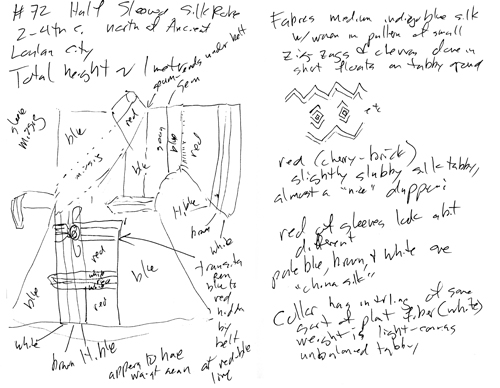
Main Menu - Misc. - Clothing/Textiles - Medieval Wales - Names - Other Medieval - Publications - Harpy Publications
Click on images for full size (large)
I'm taking a slightly different approach to this set of notes due to the amount of material involved (4 pairs of notebook pages) and the percentage of the content that is text. After the thumbnails and links to the scans of the originals, I've presented the cleaned-up sketches with only the minimum of annotations on the image files themselves and the majority of the notes presented (in a more logical order) in text format.
Because I've reorganized some of the notes, a bit of back-and-forth may be necessary to put together the fabric, color, dimension, and construction information.
I have two different notes on the overall height of the garment, one saying ca. 1 meter, the other saying ca. 30". I think the second is more accurate as I was making an extensive set of estimated measurements at that time. These follow:
The main fabric is a medium indigo blue silk with a woven-in pattern of small zig-zags and chevrons formed by short floats on a tabby ground (as seen in the following figure). This is a type of weave I've seen before associated with early Chinese textiles that ended up in the West.
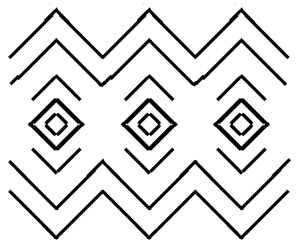
The red of the main body of the robe is a cherry-brick red and the weave is a slightly slubby silk tabby, almost like a very nice quality duppioni. The red of the sleeves (and the stripes on the belts) looks like a different fabric although the color is similar but a little lighter. The colored bands on the sleeves and the edge of the front flap are a pale indigo blue, brown, and white "china silk".
There is an interlining showing where the collar is damaged which appaers to be some sort of undyed (white) plant fiber in an unbalanced tabby weave with a weight similar to a light canvas.
The following images shows an overview of the garment. The right sleeve is missing. The (main) blue fabric appears to have a horizontal waist seam hidden by the belt because the left uppor portion has a vertical seam that does not continue in the skirt portion. Similarly the right half of the skirt portion is red, joined to a blue upper portion with the seam hidden by the belt.
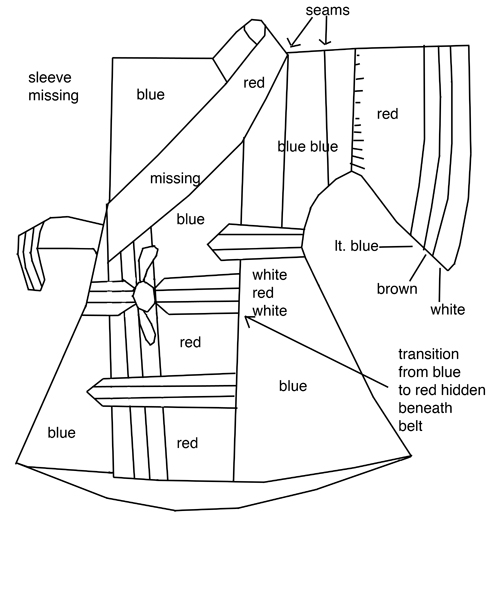
This colored-in version completes some of the portions that are damaged in the original.
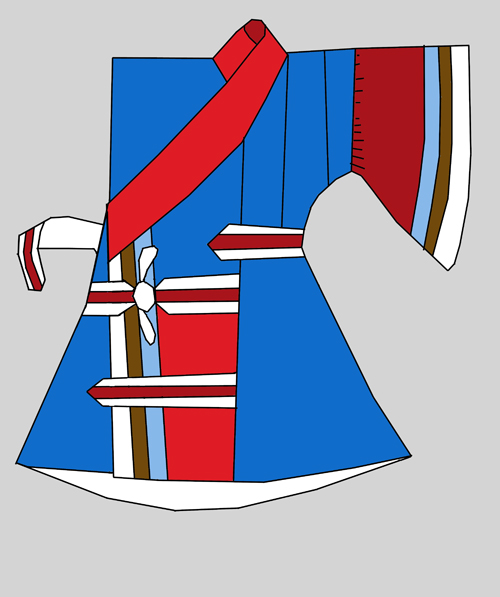
The collar is much damaged but this allows us some invaluable looks at its internal construction.
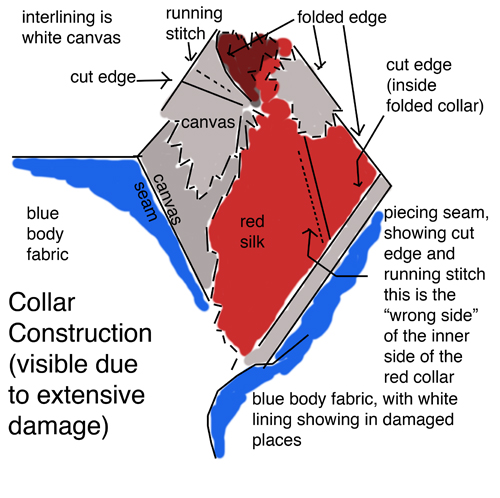
The original sketch includes two interpretations of the collar in cross-section, but the sketch here shows only the one I concluded was correct.
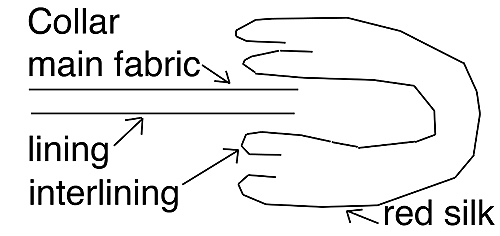
There is a belt at the waist that encircles the waist, although it looks a bit short for the ends to tie together (at least in anything more elaborate than a square knot). The fastening method is unclear as it is displayed with the ends left loose.
But there are also two "half-belts" lower on the skirt. One piece of these belts emerges from the center front seam of the outer flap of the skirt. Only the upper one also has the other half of the belt visible (possibly the other half-belt is missing) and it emerges from the (non-visible) back side of the garment to tie in a single-loop bow knot. If the back of the garment is roughly symmetric in design with the front, I assume the back skirt is also parti-colored and that the skirt-belts are similarly sewn into the central seam. The upper skirt-belt is aligned with the "corner" of the front flap.
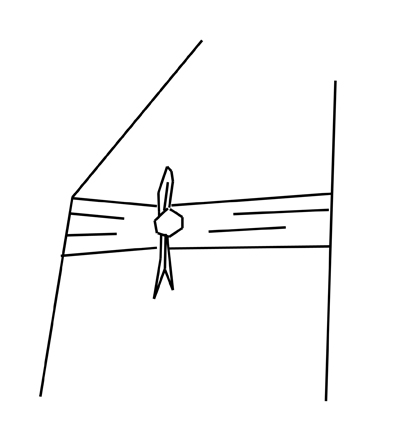
All the belts have the same construction: a turned tube of white "china" silk made from a single length of fabric (i.e., with a fold on one side and a right-sides-together seam on the other) with an appliqued stripe made from the same red fabric that is used for the sleeves (not the red used for the collar or skirt) with the edges turned under. The ends are pointed with the edges turned into the interior.
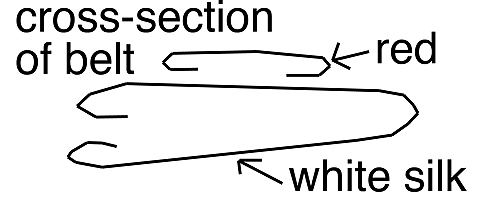
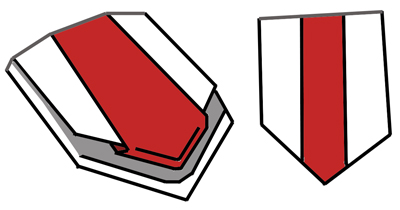
The edge of the skirt flap and the edge of the sleeve are decorated with a series of stripes of colors (the same set of colors in the same order for both). The white lining is folded to the front to form the outermost stripe, followed by brown then light blue and then a broader piece of the main red fabric. The white, brown, and blue stripes are essentially identical in width. No stitching is visible where the stripes are joined (possibly a running stitch?) but they were clearly sewn right-sides-together and the edges are uneven as if the underlying seam were pressed to one side rather than flattened, but not in the same direction in all cases. The sketches below show a guess at the underlying structure for the skirt and then the sleeve, based on this indication. For the skirt, although I show the stitching for each stripe going through all the underlying layers, this is pure guesswork and it's just as likely that the seams only go through the two adjoining pieces of fabric and not through the underlying lining as well.

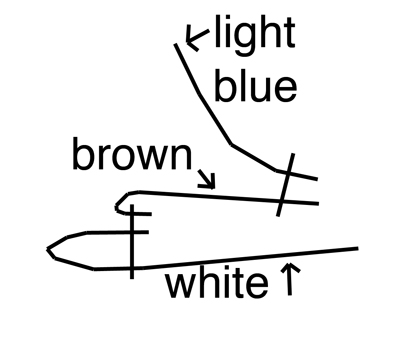
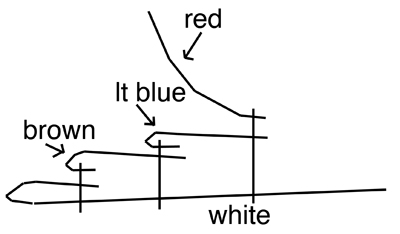

I have a note on one of the sleeve joins that there may or may not be a line of top-stitching along the join line of the (non-visible) seam.
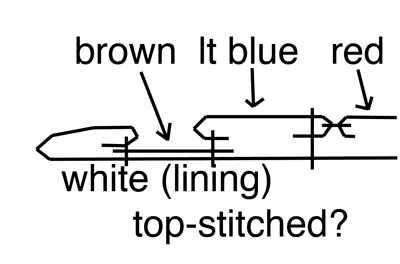
The skirt hem has the same construction on all edges.
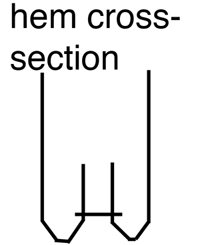
The sleeve is formed from an extension of the main (blue) body fabric to which is attached a gathered sleeve in red (edged with stripes). The sleeve is heavily gathered in the lower third but only slightly in the upper two-thirds. The lower third has about the same amount of fabric as the upper part. A damaged area shows that the gathering is done with a pair of parallel running stitches that go through both the main fabric and the (white) lining.
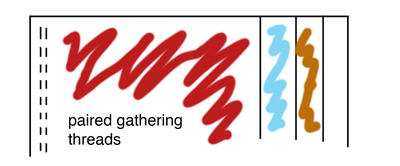
Here is a cross-section diagram of how the sleeve is joined to the body.
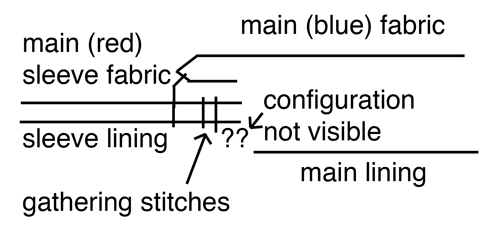
This site belongs to Heather Rose Jones. Contact me regarding anything beyond personal, individual use of this material.
Unless otherwise noted, all contents are copyright by Heather Rose Jones, all rights reserved.